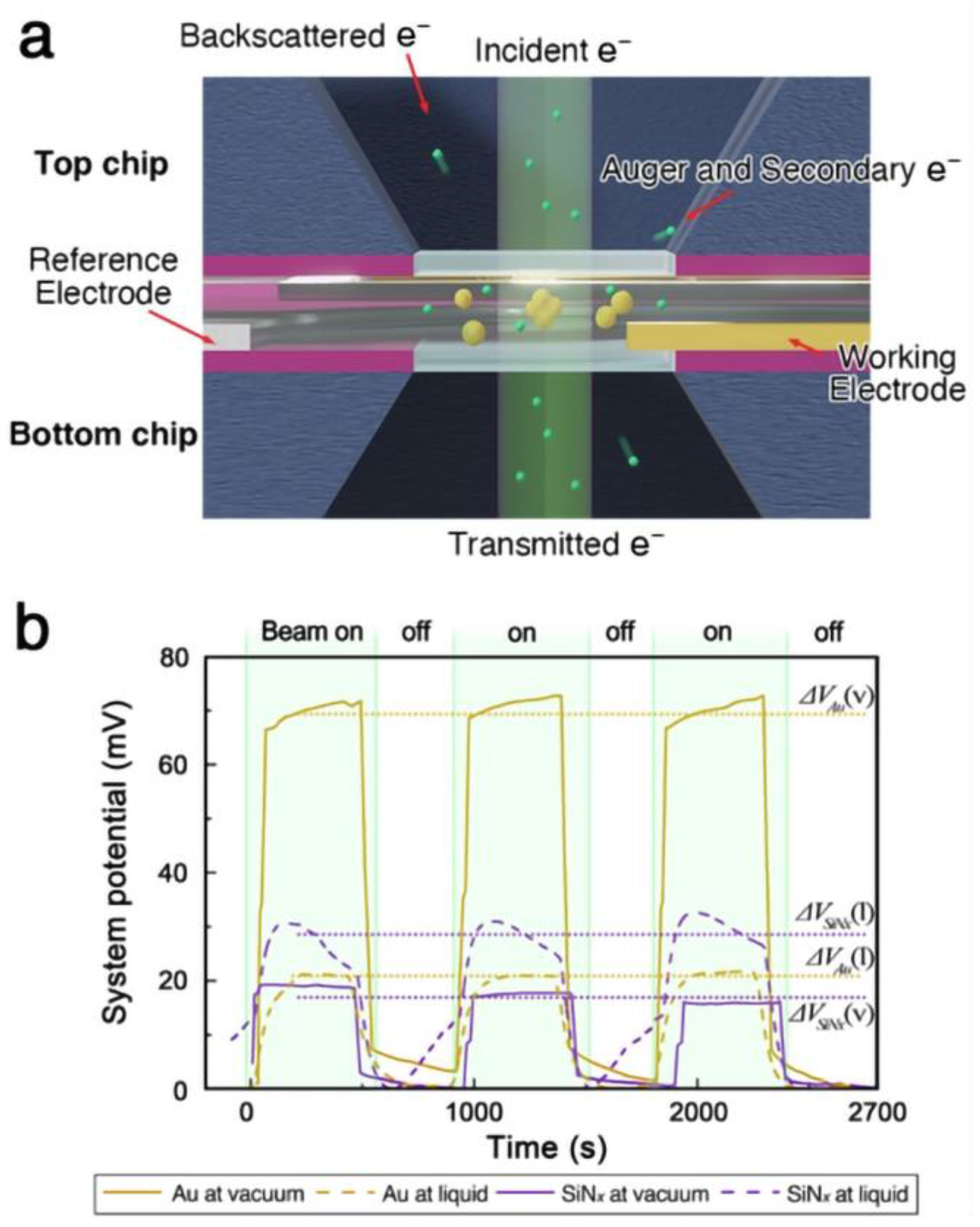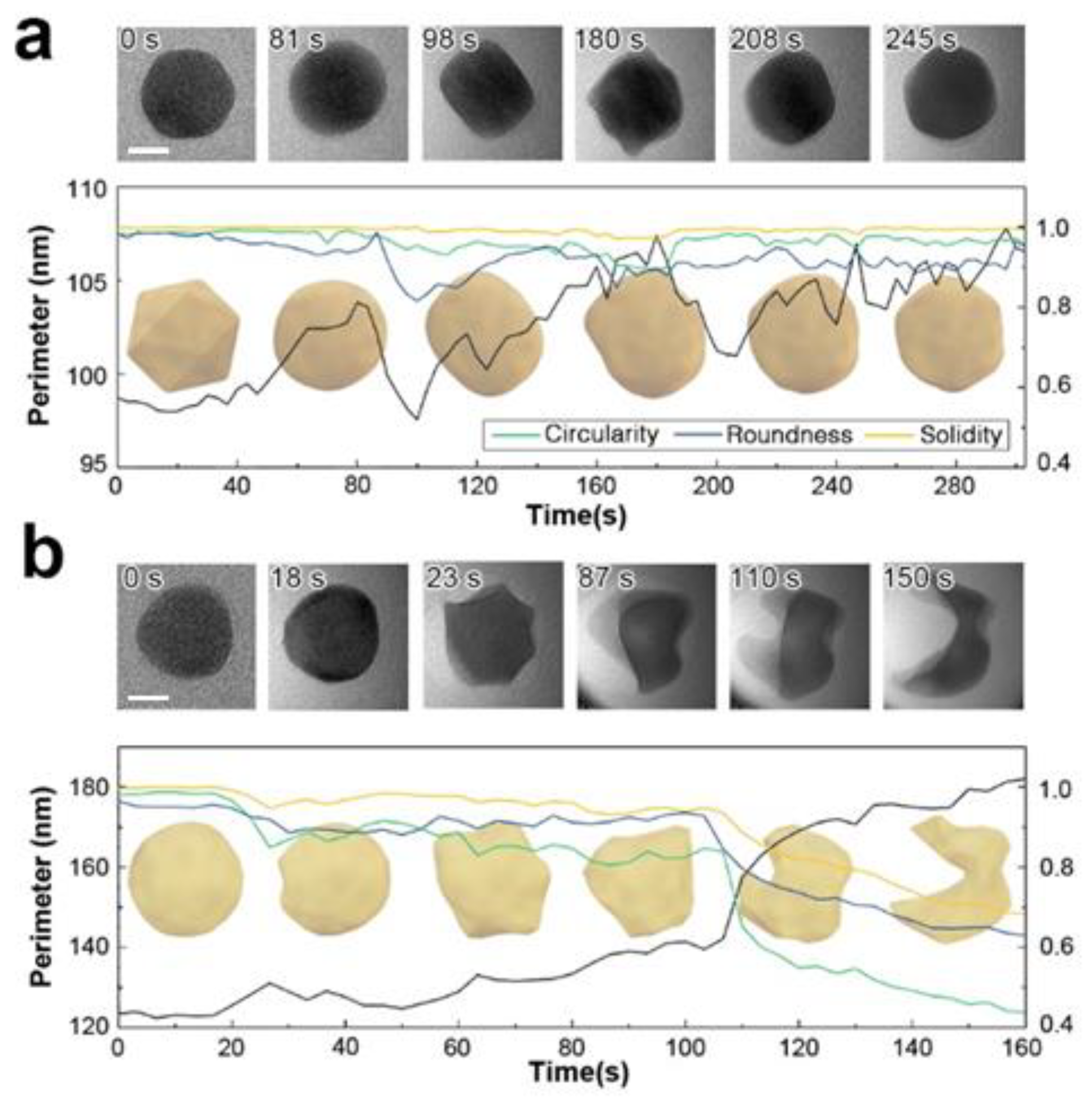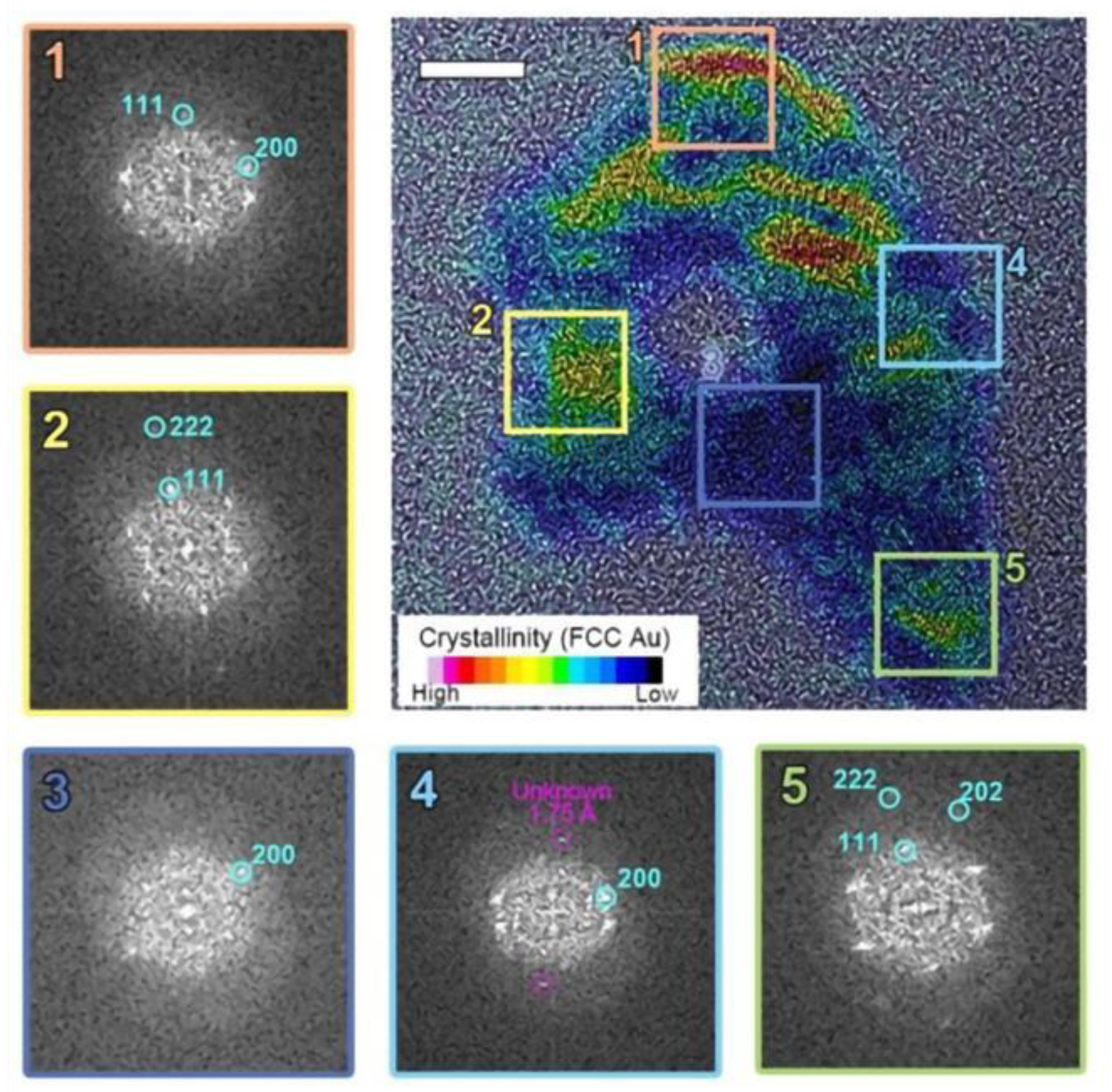Investigating Charge-Induced Transformations of Metal Nanoparticles in a Radically-Inert Liquid: A Liquid-Cell TEM Study
Abstract
1. Introduction
2. Experimental Methods
3. Results and Discussion
3.1. Charge-Induced Breakdown of Nanoparticles in a Liquid Cell Electron Microscopy
3.2. Morphology Change of Nanoparticle During Charge-Induced Melt
3.3. Crystallographic Evolution of Nanoparticle During Charge-Induced Melt
4. Conclusions
Author Contributions
Funding
Data Availability Statement
Acknowledgments
Conflicts of Interest
References
- Berry, J.; Elder, K.R.; Grant, M. Melting at Dislocations and Grain Boundaries: A Phase Field Crystal Study. Phys. Rev. B 2008, 77, 224114. [Google Scholar] [CrossRef]
- Kim, H.-S.; An, J.-S.; Bae, H.B.; Chung, S.-Y. Atomic-Scale Observation of Premelting at 2D Lattice Defects inside Oxide Crystals. Nat. Commun. 2023, 14, 2255. [Google Scholar] [CrossRef] [PubMed]
- Williamson, M.J.; Tromp, R.M.; Vereecken, P.M.; Hull, R.; Ross, F.M. Dynamic Microscopy of Nanoscale Cluster Growth at the Solid–Liquid Interface. Nat. Mater. 2003, 2, 532–536. [Google Scholar] [CrossRef] [PubMed]
- Ross, F.M. Opportunities and Challenges in Liquid Cell Electron Microscopy. Science 2015, 350, aaa9886. [Google Scholar] [CrossRef] [PubMed]
- De Jonge, N.; Ross, F.M. Electron Microscopy of Specimens in Liquid. Nat. Nanotechnol. 2011, 6, 695–704. [Google Scholar] [CrossRef]
- Zheng, H.; Smith, R.K.; Jun, Y.; Kisielowski, C.; Dahmen, U.; Alivisatos, A.P. Observation of Single Colloidal Platinum Nanocrystal Growth Trajectories. Science 2009, 324, 1309–1312. [Google Scholar] [CrossRef]
- Liao, H.-G.; Zherebetskyy, D.; Xin, H.; Czarnik, C.; Ercius, P.; Elmlund, H.; Pan, M.; Wang, L.-W.; Zheng, H. Facet Development during Platinum Nanocube Growth. Science 2014, 345, 916–919. [Google Scholar] [CrossRef]
- Loh, N.D.; Sen, S.; Bosman, M.; Tan, S.F.; Zhong, J.; Nijhuis, C.A.; Král, P.; Matsudaira, P.; Mirsaidov, U. Multistep Nucleation of Nanocrystals in Aqueous Solution. Nat. Chem. 2017, 9, 77–82. [Google Scholar] [CrossRef]
- Yuk, J.M.; Park, J.; Ercius, P.; Kim, K.; Hellebusch, D.J.; Crommie, M.F.; Lee, J.Y.; Zettl, A.; Alivisatos, A.P. High-Resolution EM of Colloidal Nanocrystal Growth Using Graphene Liquid Cells. Science 2012, 336, 61–64. [Google Scholar] [CrossRef]
- Jeong, M.; Yuk, J.M.; Lee, J.Y. Observation of Surface Atoms during Platinum Nanocrystal Growth by Monomer Attachment. Chem. Mater. 2015, 27, 3200–3202. [Google Scholar] [CrossRef]
- Keskin, S.; De Jonge, N. Reduced Radiation Damage in Transmission Electron Microscopy of Proteins in Graphene Liquid Cells. Nano Lett. 2018, 18, 7435–7440. [Google Scholar] [CrossRef] [PubMed]
- Nagamanasa, K.H.; Wang, H.; Granick, S. Liquid-Cell Electron Microscopy of Adsorbed Polymers. Adv. Mater. 2017, 29, 1703555. [Google Scholar] [CrossRef] [PubMed]
- Koo, K.; Park, J.; Ji, S.; Toleukhanova, S.; Yuk, J.M. Liquid-Flowing Graphene Chip-Based High-Resolution Electron Microscopy. Adv. Mater. 2020, 33, 2005468. [Google Scholar] [CrossRef] [PubMed]
- Noh, N.; Park, J.; Park, J.S.; Koo, K.; Park, J.Y.; Yuk, J.M. Lithographically Patterned Well-Type Graphene Liquid Cells with Rational Designs. Lab Chip 2020, 20, 2796–2803. [Google Scholar] [CrossRef]
- Dunn, G.; Adiga, V.P.; Pham, T.; Bryant, C.; Horton-Bailey, D.J.; Belling, J.N.; LaFrance, B.; Jackson, J.A.; Barzegar, H.R.; Yuk, J.M.; et al. Graphene-Sealed Flow Cells for In Situ Transmission Electron Microscopy of Liquid Samples. ACS Nano 2020, 14, 9637–9643. [Google Scholar] [CrossRef]
- Dae, K.S.; Chang, J.H.; Koo, K.; Park, J.; Kim, J.S.; Yuk, J.M. Real-Time Observation of CaCO3 Mineralization in Highly Supersaturated Graphene Liquid Cells. ACS Omega 2020, 5, 14619–14624. [Google Scholar] [CrossRef]
- Ghodsi, S.M.; Anand, S.; Shahbazian-Yassar, R.; Shokuhfar, T.; Megaridis, C.M. In Situ Study of Molecular Structure of Water and Ice Entrapped in Graphene Nanovessels. ACS Nano 2019, 13, 4677–4685. [Google Scholar] [CrossRef]
- Wang, C.; Qiao, Q.; Shokuhfar, T.; Klie, R.F. High-Resolution Electron Microscopy and Spectroscopy of Ferritin in Biocompatible Graphene Liquid Cells and Graphene Sandwiches. Adv. Mater. 2014, 26, 3410–3414. [Google Scholar] [CrossRef] [PubMed]
- Cheong, J.Y.; Chang, J.H.; Seo, H.K.; Yuk, J.M.; Shin, J.W.; Lee, J.Y.; Kim, I.-D. Growth Dynamics of Solid Electrolyte Interphase Layer on SnO2 Nanotubes Realized by Graphene Liquid Cell Electron Microscopy. Nano Energy 2016, 25, 154–160. [Google Scholar] [CrossRef]
- Chang, J.H.; Cheong, J.Y.; Kim, S.J.; Shim, Y.-S.; Park, J.Y.; Seo, H.K.; Dae, K.S.; Lee, C.-W.; Kim, I.-D.; Yuk, J.M. Graphene Liquid Cell Electron Microscopy of Initial Lithiation in Co3O4 Nanoparticles. ACS Omega 2019, 4, 6784–6788. [Google Scholar] [CrossRef]
- Chang, J.H.; Cheong, J.Y.; Yuk, J.M.; Kim, C.; Kim, S.J.; Seo, H.K.; Kim, I.-D.; Lee, J.Y. Direct Realization of Complete Conversion and Agglomeration Dynamics of SnO2 Nanoparticles in Liquid Electrolyte. ACS Omega 2017, 2, 6329–6336. [Google Scholar] [CrossRef] [PubMed]
- Fernando, I.; Tay, Y.Y.; Karunasekera, H.; Zhou, Y. Observation of the Interactions of Silver Nanoparticles (AgNPs) Mediated by Acid in the Aquatic Matrices Using in-Situ Liquid Cell Transmission Electron Microscopy. Anal. Chim. Acta 2020, 1104, 47–52. [Google Scholar] [CrossRef] [PubMed]
- Aabdin, Z.; Xu, X.M.; Sen, S.; Anand, U.; Král, P.; Holsteyns, F.; Mirsaidov, U. Transient Clustering of Reaction Intermediates during Wet Etching of Silicon Nanostructures. Nano Lett. 2017, 17, 2953–2958. [Google Scholar] [CrossRef]
- Dachraoui, W.; Keller, D.; Henninen, T.R.; Ashton, O.J.; Erni, R. Atomic Mechanisms of Nanocrystallization via Cluster-Clouds in Solution Studied by Liquid-Phase Scanning Transmission Electron Microscopy. Nano Lett. 2021, 21, 2861–2869. [Google Scholar] [CrossRef]
- Woehl, T.J.; Evans, J.E.; Arslan, I.; Ristenpart, W.D.; Browning, N.D. Direct in Situ Determination of the Mechanisms Controlling Nanoparticle Nucleation and Growth. ACS Nano 2012, 6, 8599–8610. [Google Scholar] [CrossRef]
- Arán-Ais, R.M.; Rizo, R.; Grosse, P.; Algara-Siller, G.; Dembélé, K.; Plodinec, M.; Lunkenbein, T.; Chee, S.W.; Cuenya, B.R. Imaging Electrochemically Synthesized Cu2O Cubes and Their Morphological Evolution under Conditions Relevant to CO2 Electroreduction. Nat. Commun. 2020, 11, 3489. [Google Scholar] [CrossRef]
- Lee, S.-Y.; Shangguan, J.; Alvarado, J.; Betzler, S.; Harris, S.J.; Doeff, M.M.; Zheng, H. Unveiling the Mechanisms of Lithium Dendrite Suppression by Cationic Polymer Film Induced Solid–Electrolyte Interphase Modification. Energy Environ. Sci. 2020, 13, 1832–1842. [Google Scholar] [CrossRef]
- Nagashima, S.; Ikai, T.; Sasaki, Y.; Kawasaki, T.; Hatanaka, T.; Kato, H.; Kishita, K. Atomic-Level Observation of Electrochemical Platinum Dissolution and Redeposition. Nano Lett. 2019, 19, 7000–7005. [Google Scholar] [CrossRef]
- Keskin, S.; Besztejan, S.; Kassier, G.; Manz, S.; Bücker, R.; Riekeberg, S.; Trieu, H.K.; Rentmeister, A.; Miller, R.J.D. Visualization of Multimerization and Self-Assembly of DNA-Functionalized Gold Nanoparticles Using In-Liquid Transmission Electron Microscopy. J. Phys. Chem. Lett. 2015, 6, 4487–4492. [Google Scholar] [CrossRef]
- Schneider, N.M.; Norton, M.M.; Mendel, B.J.; Grogan, J.M.; Ross, F.M.; Bau, H.H. Electron–Water Interactions and Implications for Liquid Cell Electron Microscopy. J. Phys. Chem. C 2014, 118, 22373–22382. [Google Scholar] [CrossRef]
- Wang, C.; Shokuhfar, T.; Klie, R.F. Precise In Situ Modulation of Local Liquid Chemistry via Electron Irradiation in Nanoreactors Based on Graphene Liquid Cells. Adv. Mater. 2016, 28, 7716–7722. [Google Scholar] [CrossRef] [PubMed]
- Le Caër, S. Water Radiolysis: Influence of Oxide Surfaces on H2 Production under Ionizing Radiation. Water 2011, 3, 235–253. [Google Scholar] [CrossRef]
- De Yoreo, J.J.; Sommerdijk, N. Investigating Materials Formation with Liquid-Phase and Cryogenic TEM. Nat. Rev. Mater. 2016, 1, 16035. [Google Scholar] [CrossRef]
- Cho, H.; Jones, M.R.; Nguyen, S.C.; Hauwiller, M.R.; Zettl, A.; Alivisatos, A.P. The Use of Graphene and Its Derivatives for Liquid-Phase Transmission Electron Microscopy of Radiation-Sensitive Specimens. Nano Lett. 2017, 17, 414–420. [Google Scholar] [CrossRef] [PubMed]
- Koo, K.; Dae, K.S.; Hahn, Y.K.; Yuk, J.M. Live Cell Electron Microscopy Using Graphene Veils. Nano Lett. 2020, 20, 4708–4713. [Google Scholar] [CrossRef]
- Lifshitz, A.; Tamburu, C. Thermal Decomposition of Acetonitrile. Kinetic Modeling. Int. J. Chem. Kinet. 1998, 30, 341–347. [Google Scholar] [CrossRef]
- Hioe, J.; Šakić, D.; Vrček, V.; Zipse, H. The Stability of Nitrogen-Centered Radicals. Org. Biomol. Chem. 2015, 13, 157–169. [Google Scholar] [CrossRef]
- Zipse, H. Radical Stability: A Theoretical Perspective. ChemInform 2006, 37, chin.200650275. [Google Scholar] [CrossRef]
- Council, N.R. International Critical Tables of Numerical Data, Physics, Chemistry and Technology; The National Academies Press: Washington, DC, USA, 1930. [Google Scholar]
- Brink, J.; Sherman, M.B.; Berriman, J.; Chiu, W. Evaluation of Charging on Macromolecules in Electron Cryomicroscopy. Ultramicroscopy 1998, 72, 41–52. [Google Scholar] [CrossRef]
- Glaeser, R.M. Retrospective: Radiation Damage and Its Associated “Information Limitations”. J. Struct. Biol. 2008, 163, 271–276. [Google Scholar] [CrossRef]
- Russo, C.J.; Henderson, R. Charge Accumulation in Electron Cryomicroscopy. Ultramicroscopy 2018, 187, 43–49. [Google Scholar] [CrossRef] [PubMed]
- Egerton, R.F.; Li, P.; Malac, M. Radiation Damage in the TEM and SEM. Micron 2004, 35, 399–409. [Google Scholar] [CrossRef] [PubMed]
- Beleggia, M.; Kasama, T.; Dunin-Borkowski, R.E.; Hofmann, S.; Pozzi, G. Direct Measurement of the Charge Distribution along a Biased Carbon Nanotube Bundle Using Electron Holography. Appl. Phys. Lett. 2011, 98, 243101. [Google Scholar] [CrossRef]
- Beleggia, M.; Gontard, L.C.; Dunin-Borkowski, R.E. Local Charge Measurement Using Off-Axis Electron Holography. J. Phys. Appl. Phys. 2016, 49, 294003. [Google Scholar] [CrossRef]
- Cazaux, J. Correlations between Ionization Radiation Damage and Charging Effects in Transmission Electron Microscopy. Ultramicroscopy 1995, 60, 411–425. [Google Scholar] [CrossRef]
- De Knoop, L.; Juhani Kuisma, M.; Löfgren, J.; Lodewijks, K.; Thuvander, M.; Erhart, P.; Dmitriev, A.; Olsson, E. Electric-Field-Controlled Reversible Order-Disorder Switching of a Metal Tip Surface. Phys. Rev. Mater. 2018, 2, 085006. [Google Scholar] [CrossRef]
- Jeon, S.; Heo, T.; Hwang, S.-Y.; Ciston, J.; Bustillo, K.C.; Reed, B.W.; Ham, J.; Kang, S.; Kim, S.; Lim, J.; et al. Reversible Disorder-Order Transitions in Atomic Crystal Nucleation. Science 2021, 371, 498–503. [Google Scholar] [CrossRef]
- Jo, W.; Westermeier, F.; Rysov, R.; Leupold, O.; Schulz, F.; Tober, S.; Markmann, V.; Sprung, M.; Ricci, A.; Laurus, T.; et al. Nanosecond X-Ray Photon Correlation Spectroscopy Using Pulse Time Structure of a Storage-Ring Source. IUCrJ 2021, 8, 124–130. [Google Scholar] [CrossRef]
- Konrad, B.; Fabrim, Z.E.; Timm, M.M.; Fichtner, P.F.P. Electron Irradiation Effects on Ag Nanoparticles. J. Mater. Sci. 2021, 56, 8202–8208. [Google Scholar] [CrossRef]



Disclaimer/Publisher’s Note: The statements, opinions and data contained in all publications are solely those of the individual author(s) and contributor(s) and not of MDPI and/or the editor(s). MDPI and/or the editor(s) disclaim responsibility for any injury to people or property resulting from any ideas, methods, instructions or products referred to in the content. |
© 2024 by the authors. Licensee MDPI, Basel, Switzerland. This article is an open access article distributed under the terms and conditions of the Creative Commons Attribution (CC BY) license (https://creativecommons.org/licenses/by/4.0/).
Share and Cite
Koo, K.; Seo, J.H.; Lee, J.; Lee, S.; Kwon, J.-H. Investigating Charge-Induced Transformations of Metal Nanoparticles in a Radically-Inert Liquid: A Liquid-Cell TEM Study. Nanomaterials 2024, 14, 1709. https://doi.org/10.3390/nano14211709
Koo K, Seo JH, Lee J, Lee S, Kwon J-H. Investigating Charge-Induced Transformations of Metal Nanoparticles in a Radically-Inert Liquid: A Liquid-Cell TEM Study. Nanomaterials. 2024; 14(21):1709. https://doi.org/10.3390/nano14211709
Chicago/Turabian StyleKoo, Kunmo, Jong Hyeok Seo, Joohyun Lee, Sooheyong Lee, and Ji-Hwan Kwon. 2024. "Investigating Charge-Induced Transformations of Metal Nanoparticles in a Radically-Inert Liquid: A Liquid-Cell TEM Study" Nanomaterials 14, no. 21: 1709. https://doi.org/10.3390/nano14211709
APA StyleKoo, K., Seo, J. H., Lee, J., Lee, S., & Kwon, J.-H. (2024). Investigating Charge-Induced Transformations of Metal Nanoparticles in a Radically-Inert Liquid: A Liquid-Cell TEM Study. Nanomaterials, 14(21), 1709. https://doi.org/10.3390/nano14211709







